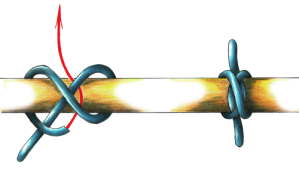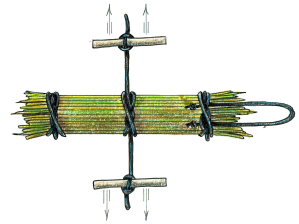 The constrictor knot is a very effective binding knot and was first termed by Clifford Ashley in his seminal work, “The Ashley Book of Knots“. Although Mr. Ashley implied that he invented the knot, further research has shown that the knot actually existed under other names many years before Ashley’s claim. Although I agree that the history of such things is important for posterity, the actual knot is where my interests lay and I will leave its origins for you to discover on your own.
The constrictor knot is a very effective binding knot and was first termed by Clifford Ashley in his seminal work, “The Ashley Book of Knots“. Although Mr. Ashley implied that he invented the knot, further research has shown that the knot actually existed under other names many years before Ashley’s claim. Although I agree that the history of such things is important for posterity, the actual knot is where my interests lay and I will leave its origins for you to discover on your own.
The constrictor knot is easy to learn and remember which means you will have it at the ready when the need presents its self. The knot excels at binding several, especially cylindrical, objects together. It is tied in such a way that it binds upon its self. The tighter you cinch it down the tighter it holds. So much so, that once tightened it is very difficult, if not impossible, to untie. Often cutting is the quickest way to remove the constrictor knot.
 The knot can be employed as a temporary whipping for multiple strand rope or to bind several strands of loose material, such as straw or twine, together. The latter application being where I employ the constrictor knot most often. I used it to bind strands of broom corn together when making my polissoir for instance. In tying several decorative knots, multiple strands of twine are employed and the quickest way of binding these is to use the constrictor knot.
The knot can be employed as a temporary whipping for multiple strand rope or to bind several strands of loose material, such as straw or twine, together. The latter application being where I employ the constrictor knot most often. I used it to bind strands of broom corn together when making my polissoir for instance. In tying several decorative knots, multiple strands of twine are employed and the quickest way of binding these is to use the constrictor knot.
Several of the knots that I plan to share in the future will begin by using the constrictor knot to bind several strands of twine together. That is why I am presenting it here. It is a knot that you, if you plan to follow along, will need time and again. Beyond that, it is just a handy knot to know how to tie.
Greg Merritt


I was very surprised at how well this knot works. Your posting a few weeks ago led me to rework my hastily made pollisor. I originally made mine with plastic cable ties, only one smidgen more comfortable to handle than metal hose clamps. 🙂 Along came your article and I skeptically replaced the cable ties with constrictor knots and was very pleasantly surprised they hold as well, or better, than the plastic ties. … and the tool is far more comfortable to use and attractive as well.
THANKS!
Your welcome Bob.
It is difficult to convey the true utility of this simple knot through words and drawings. The knot needs to be experienced. Once you tie it, you understand why its called the constrictor knot.
I’m happy that it work out well for you on your polissoir and thank you for taking the time to comment.
Greg
I love the posts and pdfs on knots. As a former Eagle Scout knows have always been an interest of mine. Guess I’ll have to follow you down this rabbit hole, lol. I found your blog from Paul Sellers’ site, where your other drawings are great as well.
Welcome to my blog Scott. Hopefully I do not lead you too far astray. I’m trying to get a base of information posted here before I jump into more involved projects. That way both readers and I have a set of reference information and drawings.
Thank you for the kind words regarding my drawings. Drawing is how I think through a project and I find hand drawing relaxing.
Thanks for taking the time to comment.
Greg
I have always found knots interesting but never really looked into them in any detail. This might just give me the information I need to get started. Although, I’m still a bit stumped by the lanyard knot!
I hope that I can help to get you started Franco. What about the lanyard knot has you stumped? I hope that I can clear it up for you.
Greg
I couldn’t get to the stage of the drawing you showed. When I thought I had it, it tied up into a muddeld mess, so I don’t think I had it right. Though I see you’ve posted some photo’s which should make it clearer. Thanks.
Pingback: Build Yourself a Hide Glue Brush | HILLBILLY DAIKU